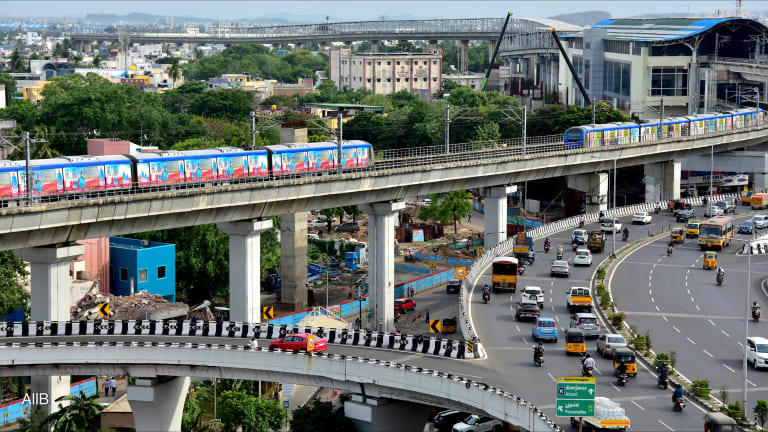ADB-Georgia Partnership
Through 2018, the Asian Development Bank will be focusing its support for Georgia on the transportation, water, energy, public sector management and finance sectors.
A new section of the Kobuleti bypass road in Georgia. Photo by: Gia Chkhatarashvili / Asian Development Bank / CC BY-NC-ND Over the past decade, Georgia’s economy improved steadily largely due to its government’s aggressive implementation of broad economic and institutional reforms. Even so, the country is faced with high unemployment. The slow growth in jobs, in particular, is a major challenge especially for the country’s youth. Agriculture currently employs half of the population but productivity growth in the sector is low. Further, there remain pockets of poverty, with 21.4 percent of the population living below the poverty line. To address these problems, the government development Georgia 2020, a socio-economic development strategy that envisions “a country where every member of society will enjoy the benefits of economic growth and where the potential of every citizen will fully contribute to the country’s development.” The Asian Development Bank aligned its 2014-2018 country partnership strategy with the objectives of Georgia 2020. For the next three years, bank intervention in Georgia will promote environmental sustainability, inclusive economic growth and regional connectivity. The partnership strategy will be supplemented by the Country Operations Business Plan 2015-2017, which will also focus on transport, water and other urban infrastructure, energy, finance and public sector management. Funding levels and priorities ADB is one of Georgia’s largest multilateral partners. As of 2013, it has provided $1.4 billion worth of sovereign and nonsovereign loans, most of which were channeled to the transportation sector. Shown on below are ADB commitments to Georgia since 2007, covering allocations from the Asian Development Fund, overseas capital resources and other special funds. Under the new partnership strategy, ADB will provide an indicative amount of $699 million to finance pipeline projects. Meanwhile, it will also provide $516 million for the 2015-2017 operations business plan. The 2014-2018 partnership strategy hinges on three pillars: inclusive economic growth, regional integration and environmentally sustainable growth. It supports five priority areas, namely: Transportation: ADB’s main objective is to improve the transport and logistical infrastructure and services to increase access to efficient, reliable, safe and sustainable transportation in Georgia. To do this, the bank will support the multitranche financing of the East-West Highway and repair of secondary roads in poor condition. Technical expertise will be provided as well. Water and other urban infrastructure and services: Under this priority area, ADB aims to make good, quality, reliable and continuous water supply and improved sanitation activities accessible to more people. The bank will build on the activities of existing multitranche financing operations in the urban transport and water supply and sanitation sectors, and will provide basic infrastructure needs of small town and secondary cities. These will be supplemented by urban planning and tariff policy reforms technical assistance. Energy: This area of engagement will focus on working toward improving domestic energy supply and increasing energy trade with other countries. ADB intervention will include rehabilitating aging assets, enhancing power system reliability and constructing physical facilities for power exports. Public sector management: Despite significant improvement in recent years, the public sector in Georgia still lags in several areas. ADB will provide assistance toward public sector management reforms through introduction of pension schemes, establishment of competition agency, tax reforms, and improvement of legal and regulatory frameworks for public-private partnerships. Finance: In this area, ADB aims to boost the private sector’s access to finance, including for micro, small and midsize enterprises. At the same time, the bank will support the development of government securities and corporate bond markets to promote capital market development. Shown on the table below is the indicative resource allocation per priority area. On the other hand, the 2015-2017 operations business plan, which shares the same priorities as the partnership strategy, has $516 million in indicative financing, of which $132.5 million will be sourced from the ADF and $385.45 million from the OCR. In addition, $9.2 million will be provided for technical assistance in policy, project preparation and capacity development. Devex analysis Georgia’s economy relies heavily on foreign capital inflows, making it vulnerable macroeconomic management risks. To protect bank support, ADB will conduct targeted advisory work to strengthen the financial sector and support competitiveness and productivity by improving key sectors. The bank also notes project management risks associated with decentralization reforms, insufficient attention to regulatory and policy reforms, and funding gaps. ADB will mitigate these risks by providing technical assistance in public sector management and strengthening government capacity for safeguards and procurement. During the implementation of the partnership strategy and operations business plan, ADB will continue to closely coordinate with Georgia’s government and other development partners to ensure harmonization of efforts. To date, regular meeting and bilateral consultations are conducted with the European Bank for Reconstruction and Development, European Investment Bank, International Monetary Fund, World Bank, Japan International Cooperation Agency, Kfw Entwicklungsbank, Swedish International Development Cooperation Agency and U.S. Agency for International Development. While Georgia is among the recent members of ADB, joining only in 2007, the partnership between the two has grown stronger, as evidenced by the continuous expansion of the bank’s portfolio. Contact Georgia Resident Mission Tel: (995-32) 225-0619 Fax: (995-32) 225-0622 Email:
A new section of the Kobuleti bypass road in Georgia. Photo by: Gia Chkhatarashvili / Asian Development Bank / CC BY-NC-ND
Over the past decade, Georgia’s economy improved steadily largely due to its government’s aggressive implementation of broad economic and institutional reforms.
Even so, the country is faced with high unemployment. The slow growth in jobs, in particular, is a major challenge especially for the country’s youth. Agriculture currently employs half of the population but productivity growth in the sector is low.
This story is forDevex Promembers
Unlock this story now with a 15-day free trial of Devex Pro.
With a Devex Pro subscription you'll get access to deeper analysis and exclusive insights from our reporters and analysts.
Start my free trialRequest a group subscription Printing articles to share with others is a breach of our terms and conditions and copyright policy. Please use the sharing options on the left side of the article. Devex Pro members may share up to 10 articles per month using the Pro share tool ( ).
As former Devex editor for business insight, Aimee created and managed multimedia content and cutting-edge analysis for executives in international development.








